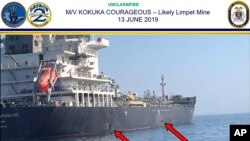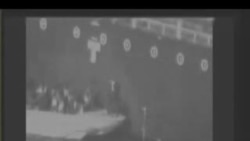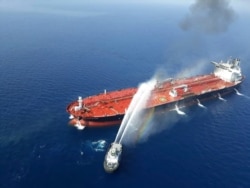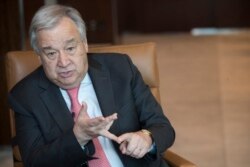Margaret Besheer and Wayne Lee contributed to this report.
U.S. Secretary of Defense Pat Shanahan said the U.S. is trying to build "international consensus" in the Middle East after an attack on two oil tankers in the Gulf of Oman.“We obviously need to make contingency plans should the situation deteriorate, but we also need to broaden our support for this international situation,” Shanahan said Friday.
The U.S. blames Iran for the attack, and the military has provided video that it says shows people on an Iranian patrol boat removing an unexploded limpet mine from the hull of the Kokuka Courageous tanker.
The vessel is owned by Kokuka Sangyo, a Japanese shipping company, and the other tanker, Front Altair, is owned by Frontline, a Norwegian company.
Frontline CEO Robert Hvide Macleod told VOA the company is in close contact with the crew, who are in Iranian custody, and they are being treated very well.
MacLeod added that the Front Altair is drifting safely and towing was to begin soon.
Frontline said a rescue tug equipped with towing capability reached the Front Altair at noon on June 14 and two further support vessels will arrive on scene on June 15 with a specialist team to inspect the tanker and make recommendations.
A U.S. official, who spoke to VOA on condition of anonymity, said Iranian fast attack craft were preventing two tug boats, which the Norwegian company had hired, from towing the Front Altair away.
The crew was taken into Iranian custody after a civilian craft, the Hyundai Dubai, rescued them.
According to a U.S. defense official, the master of the Hyundai Dubai vessel told American forces that Iranian forces surrounded his ship and "demanded" the crew of the Altair be released to them. The master said he felt "obligated and compelled" to comply, despite the crew's company instructing his ship not to turn the crew over to Iran.
Iran's state-run IRNA news agency reported that Iran's navy rescued 44 crew members from the tankers.
Both ships appear to have been struck by mines.
The U.S. Navy's Bahrain-based U.S. Fifth Fleet received distress calls from both stricken tankers about an hour apart. The guided missile destroyer USS Bainbridge approached the Dutch tug Coastal Ace, which had rescued the crew of 21 sailors from the Kokuka Courageous after the unexploded mine was discovered on the hull and they abandoned ship.
At the request of the master of the Kokuka Courageous, the sailors remained on the USS Bainbridge for several hours and were returned to their ship on Friday to go with it to port, said Army Lt. Col. Earl Brown, a spokesman for the U.S. military’s Central Command.
Brown said a large tug boat from the UAE was now moving the Kokuka toward Fujaira, which may take several days. The USS Bainbridge and USS Mason remain nearby to "keep an eye out" for the crew's safety, he added.
Japan condemned the attacks, which occurred as Japanese Prime Minister Shinzo Abe visited Iran in an effort to ease tensions in the region.
The head of the Kokuka Sangyo shipping company said their ship had been attacked twice, with one explosion near the engine room and another on the right hand side, near the back.
Speaking to reporters Friday, Yutaka Katada said crew members reported they saw a "flying object" just before the second blast on board.
Iranian Foreign Minister Javad Zarif said Thursday the timing of the latest apparent attacks was "beyond suspicious" because the Japanese prime minister was in Tehran meeting with Supreme Leader Ayatollah Ali Khamenei.
On Friday, Zarif tweeted the U.S. “immediately jumped to make allegations against Iran without a shred of factual or circumstantial evidence.” Zarif also accused the U.S. of engaging in “sabotage diplomacy” during Abe’s visit to Iran.
British Foreign Secretary Jeremy Hunt said the attacks were “deeply worrying” and that Britain believes Iran was behind the attacks. “While we will be making our own assessment soberly and carefully, our starting point is obviously to believe our U.S. allies,” Hunt said in a statement.
China said it was deeply concerned about tensions in the region and called for restraint. “Nobody wants to see war in the Gulf,” said Foreign Ministry spokesman Geng Shuang. “We hope all relevant parties remain calm and exercise restraint.”
U.N. Secretary-General Antonio Guterres voiced his concern about the rising tensions in the region.
"The world cannot afford a major confrontation in the Gulf," he said.
League of Arab States Secretary-General Ahmed Aboul Gheit was asked whether he was ready to point fingers at anyone for the incident. He replied by saying, "The facts will be revealed, I’m sure; it’s only a matter of time. As it is established — the facts — we will take positions."
The Gulf of Oman is next to the Strait of Hormuz — the strategic waterway that is a vital shipping lane. About 30% of the world's seaborne crude oil travels through the strait.
Global oil prices jumped 4% to more than $62 a barrel after the attacks.
Energy ministers from the world's largest advanced and emerging economies vowed Saturday to collaborate to maintain stability in the oil market. Japanese Industry Minister Hiroshige Seko told participants in a Group of 20 meeting in Karuizawa, Japan "It is vital for the international community to respond collaboratively to such incidents from the perspective of ensuring global energy security," Seko said.
Seko later said at a news conference, "The G-20 shared the view that it is important to work together for the stability of the energy market."
U.S. Deputy Secretary of Energy Dan Brouillette told reporters "We stand firmly with the Japanese and everyone else."
Last month, the U.S. accused Iran of using mines to attack four oil tankers off the coast of the United Arab Emirates, an accusation Iran has denied.
Navy Vice Admiral Michael Gilday specifically put the blame on Iran’s Islamic Revolutionary Guard Corps for that attack. He also said Iranian-backed “proxy” forces carried out a rocket attack in Baghdad’s Green Zone and an attack on a Saudi oil pipeline last month.
In May, the U.S. rushed the deployment of the USS Abraham Lincoln carrier strike group, including fighter jets, helicopters, naval destroyers and at least 6,000 sailors. The transport landing dock ship USS Arlington has been rerouted to the area and a B-52 bomber task force was deployed in response to the increased threat.
The U.S. also sent 900 troops to Saudi Arabia and Qatar for additional intelligence, surveillance and reconnaissance support, along with increased air and engineering support to harden the defenses of American facilities. A 600-person Patriot battalion extended its deployment in the region to defend against missile threats, while another Patriot battery was sent to assist this mission.














